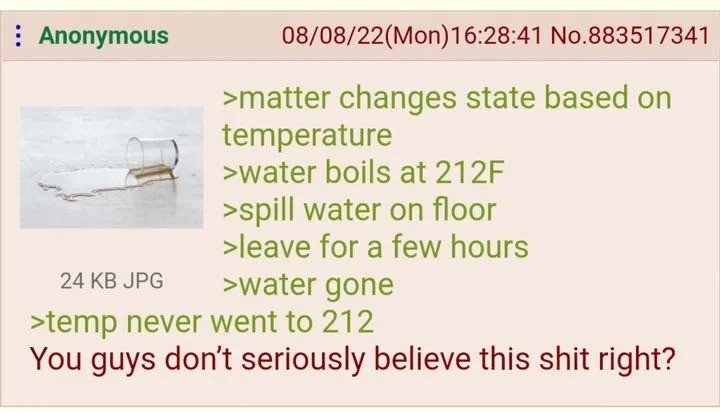this post was submitted on 17 Oct 2024
475 points (95.4% liked)
Greentext
4460 readers
1138 users here now
This is a place to share greentexts and witness the confounding life of Anon. If you're new to the Greentext community, think of it as a sort of zoo with Anon as the main attraction.
Be warned:
- Anon is often crazy.
- Anon is often depressed.
- Anon frequently shares thoughts that are immature, offensive, or incomprehensible.
If you find yourself getting angry (or god forbid, agreeing) with something Anon has said, you might be doing it wrong.
founded 1 year ago
MODERATORS
you are viewing a single comment's thread
view the rest of the comments
view the rest of the comments

My chemistry teacher once explained it to me like below. Does anyone know how much truth there is to this explanation?
Temperature as measured by a thermometer or your finger is an average. Not every single molecule has the same temperature. The molecules constantly bounce around, smashing into each other, transferring heat to each other. By chance, some molecules will get hit in just the right way by other molecules to reach a very high temperature and then it evaporates. So there is constantly a gradient of temperatures among the molecules and the ones with the highest temperature are the ones evaporating, until there is no liquid left at all.
As the average temperature increases, the chance of some molecules reaching a high enough temperature also increases, so warm water evaporates faster than cold water.
This also explains why evaporation cools down (like when you sweat): the molecules with the highest temperature are the ones evaporating, so the average temperature decreases as those high-temperature molecules leave the system. Only the relatively colder molecules are left behind - thus it cools as a whole.
There's a bit more to it, but it's because of this effect.
There is actually a balance between liquid and gas state, just overwhelmingly in favor of liquid when at normal temperatures. There is a ratio of molecules that will hit each other and transition to gas, and an equal amount gas hitting liquid and condensing. At least when there is a balance between the two sides, aka 100% moisture in the air. Which is not how it is most places.
Normally there is always evaporated water in the air, and anything that evaporated will be moved away in any mildy ventilated area, as you say, it leaves the system. So it never reaches a balance, which is why things dry up at lower temps as water will always evaporate and leave the system.